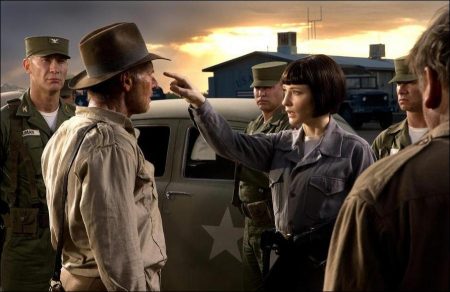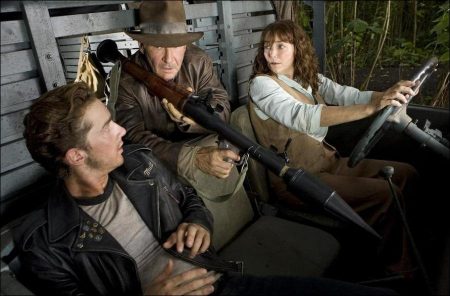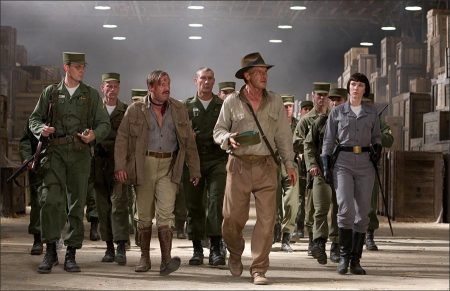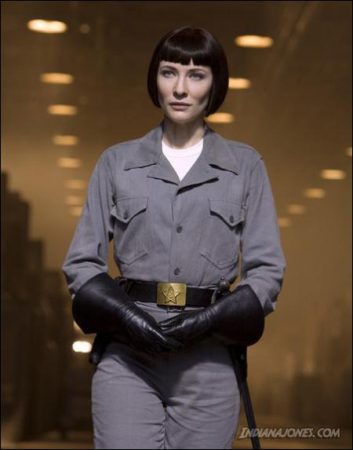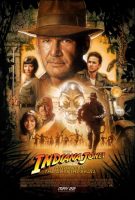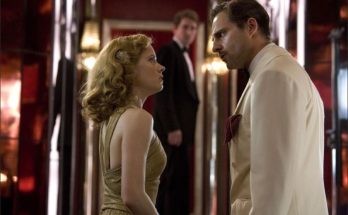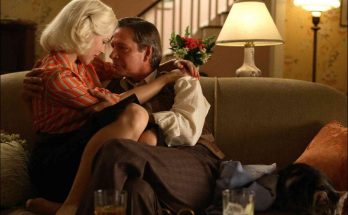His exploits are the stuff of legend and his name has become the very definition of adventure. Indiana Jones. The whip-toting, punch-packing, snake-hating, globe-trotting archaeologist with a fedora is back on screen in “Indiana Jones and the Kingdom of the Crystal Skull,” debuting worldwide Thursday, May 22, 2008.
This adventure begins in the desert Southwest in 1957 – the height of the Cold War. Indy and his sidekick Mac (Ray Winstone) have barely escaped a close scrape with nefarious Soviet agents on a remote airfield. Now, Professor Jones has returned home to Marshall College – only to find things have gone from bad to worse. His close friend and dean of the college (Jim Broadbent) explains that Indy’s recent activities have made him the object of suspicion, and that the government has put pressure on the university to fire him.
On his way out of town, Indiana meets rebellious young Mutt (Shia LaBeouf), who carries both a grudge and a proposition for the adventurous archaeologist: If he’ll help Mutt on a mission with deeply personal stakes, Indy could very well make one of the most spectacular archaeological finds in history – the Crystal Skull of Akator, a legendary object of fascination, superstition and fear. But as Indy and Mutt set out for the most remote corners of Peru – a land of ancient tombs, forgotten explorers and a rumored city of gold – they quickly realize they are not alone in their search. The Soviet agents are also hot on the trail of the Crystal Skull.
Chief among them is icy cold, devastatingly beautiful Irina Spalko (Cate Blanchett), whose elite military unit is scouring the globe for the eerie Crystal Skull, which they believe can help the Soviets dominate the world … if they can unlock its secrets. Indy and Mutt must find a way to evade the ruthless Soviets, follow an impenetrable trail of mystery, grapple with enemies and friends of questionable motives, and, above all, stop the powerful Crystal Skull from falling into the deadliest of hands.
The Return of the Great Adventure
Spielberg, Lucas and Ford Re-Team for an Adventure Worthy of the Name Indiana Jones
Like its predecessors, “Indiana Jones and the Kingdom of the Crystal Skull” is distinguished from anything else in the cinema landscape by Steven Spielberg’s unparalleled vision, George Lucas’s limitless imagination and Harrison Ford’s embodiment of a timeless adventure hero.
From his first appearance nearly 27 years ago, Indiana Jones has become one of the most beloved heroes of the silver screen, and almost since the day 1989’s “Indiana Jones and the Last Crusade” was released, audiences all over the world have announced their collective desire for another Indiana Jones adventure.
“We created Indiana Jones, but it belongs to the world,” says director Steven Spielberg. “And now we’re the custodians. Our job really is to serve up a huge helping not only of what Indiana Jones means to audiences who grew up with it, but to introduce the character to those who haven’t. This new film is for the fans.”
Executive producer and co-story writer, George Lucas, says his goal was to create an experience that will transport audiences into an all-new adventure set in a familiar world – a world that generations of fans have come to know and love. “The style is the same, the humor is the same. Everything feels the same. But we’ve also been able to build on it. The relationships we have on the set and the ones on the screen are stronger and better and more fun than they’ve ever been,” Lucas says.
Few actors have been as inextricably identified with a character as Harrison Ford is with Indiana Jones – and he returned to the role with all the style and swagger that helped turn the archaeologist-adventurer into a cinema icon. “Having been out in the world making all kinds of other movies, I was happy to do another Indiana Jones film, just because they’re so damned much fun to do,” Ford says. “I love being in business again with Steven and George, and I’ve had a great time on this one.”
Spielberg calls Ford’s casting the most important element in the unique alchemy of Indiana Jones. “More important than my directing it, more important than all the writers that came in, more important than almost the sum of all of its parts, was the fact that this series would not have been as successful as it was if it were not for Harrison Ford playing that role,” says Spielberg. “Harrison is at home in the skin of Indiana Jones.”
For years after the release of “Last Crusade,” Spielberg harbored a belief that the time for Indiana Jones had ended. “I shot Indiana Jones riding a horse into the sunset because I thought that brought the curtain down on the story,” he remarks. “And in a sweet, nostalgic way, that was fine with me at the time. But there were some people who weren’t fine with it – and this movie really started with the fans.”
It took the energy, enthusiasm and persistence of Harrison Ford to inspire the team to reunite for another adventure. “Harrison called me and said, `Why don’t we make another one of these pictures? There’s a fan base out there that wants it,’” Spielberg recalls. “He was tenacious. He called George, and George got to thinking about it, and then George called me and said, `Well, Steve, what do you want to do? It could be fun to make another movie.’”
“I have to give the credit to Harrison for starting the ball rolling and then to George for working to get me to consider the possibility of at least one more story,” Spielberg says.
Together, Spielberg, Lucas and Ford agreed that they would only pursue a fourth Indiana Jones adventure if the idea – and the execution – were up to the standards of the first three movies. It took 19 years to find just the right script – and one of the first points of agreement between the three was that 19 years should pass for Indiana Jones, too. “He is certainly older, if not wiser,” Ford jokes.
Another Time, Another Quest
Indiana Jones Ventures Into the Amazing World of the 1950s
When we last saw Indiana Jones on screen, it was 1938, and the world stood on the brink of war as Dr. Jones chased down evildoers to find the Holy Grail. Nineteen years later, he’s cracking his whip again, and many things have changed… but some have remained the same. Again, the world is at a precipice, this time caused by the specter of nuclear annihilation, and Indy’s struggle is once again to ensure that a precious, mysterious object remains safe from those bent on destroying humanity.
The story of “Indiana Jones and the Kingdom of the Crystal Skull” as created by George Lucas, Jeff Nathanson and written by David Koepp moves the era forward, and their decisions led to some unexpected – and creatively rewarding – choices about the feel of the fourth Indiana Jones adventure.
The genesis of “Raiders of the Lost Ark” was inextricably tied to Spielberg and Lucas’s respective love for movie serials from the 1930s. Those adventure classics were enormously influential on the action, adventure and suspense of first three Indiana Jones movies. But 19 years after those serials had ended, a new entertainment age had dawned. Serials gave way to television, but their sensibilities weren’t gone from the screen. By the mid-1950s, science-fiction films had become ubiquitous, especially for younger audiences craving action and adventure.
Often breathtaking, despite the fact that they were usually filmed on shoestring budgets, they were movies filled with suspicion and paranoia about the rapidly changing scientific and technological world. Though imbued with dread fueled by the Cold War, they were also optimistic about the ingenuity of mankind to overcome attacks from outer space, under the sea – or from within. The spirit of those movies is felt throughout “Indiana Jones and the Kingdom of the Crystal Skull.”
“It was important for me that the character move into the Atomic Age,” says Spielberg. “Our film takes place in 1957, which is totally informed by the Cold War, by McCarthyism, by hot rods, and girls wearing letter sweaters, ponytails, and saddle shoes. For me, the `50s were emblematic of music, of the very beginning of rock and roll. It was Technicolor. The Fifties means the bright young faces that Norman Rockwell loved to paint.”
Executive producer Kathleen Kennedy concurs, “The `50s were an interesting period, because it was still an age of innocence, a time when we were coming out of World War II and people were excited about moving into the future.”
The changes also meant the filmmakers could explore a different kind of villain. As Spielberg explains, “Setting the story in 1957 planted us firmly in the middle of the Cold War with the threat of nuclear annihilation and the Red Menace, as it used to be known in America. Those were things that were in the headlines on a daily basis, so when it came to who the villains would be, the Russians got the job.”
Despite the changes in setting and tone, some things remain undeniably the same. “All the traditions of Indiana Jones are back again,” says Spielberg. “We’ve got the map; we’ve got the plane and the vehicles with the little red line showing you how you’re hop-scotching across the globe – and it’s just part of the milieu that we’ve spent many years establishing.”
The end result is a movie for both old fans and new ones. “There’s a tremendous feeling among everyone to hit the high bar and live up to the huge expectations for this movie,” says producer Frank Marshall. “And when people ask me, `What’s the new movie like?’ the only thing I can say is: It’s Indiana Jones!”
Continue Reading and View the Theatrical Trailer
Indiana Jones and the Kingdom of Crystal Skull (2008)
Directed by: Steven Spielberg
Starring: Harrison Ford, Cate Blanchett, Karen Allen, Ray Winstone, John Hurt, Jim Broadbent, Shia LaBeouf, Jim Broadbent, Dimitri Diatchenko, Ilia Volok, Pasha D. Lychnikoff, Venya Manzyuk
Screenplay by: David Koepp
Production Design by: Kathleen Kennedy, George Lucas
Prodüksiyon Tasarımı Guy Hendrix Dyas
Cinematography by: Janusz Kaminski
Costume Design by: Mary Zophres, Bernie Pollack
Set Decoration by: Larry Dias
Art Direction by: Luke Freeborn, Lawrence A. Hubbs, Mark W. Mansbridge, Lauren E. Polizzi, Troy Sizemore
Mario Ventenilla
Music by: John Williams
MPAA Rating: PG-13 for adventure violence and scary images.
Distributed by: Paramount Pictures
Release Date: May 22, 2008
Visits: 81
